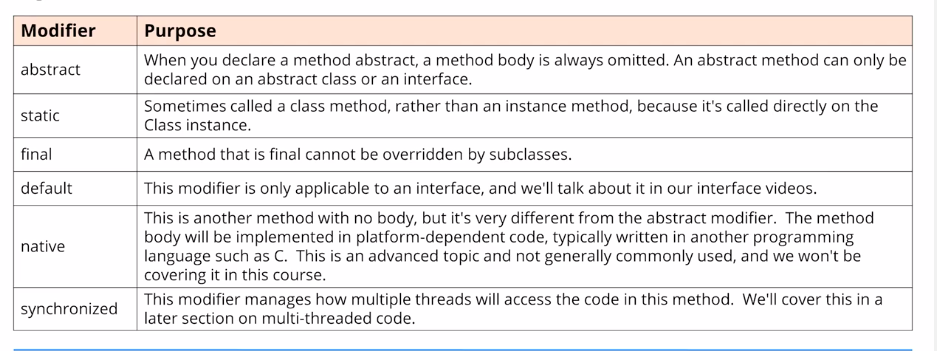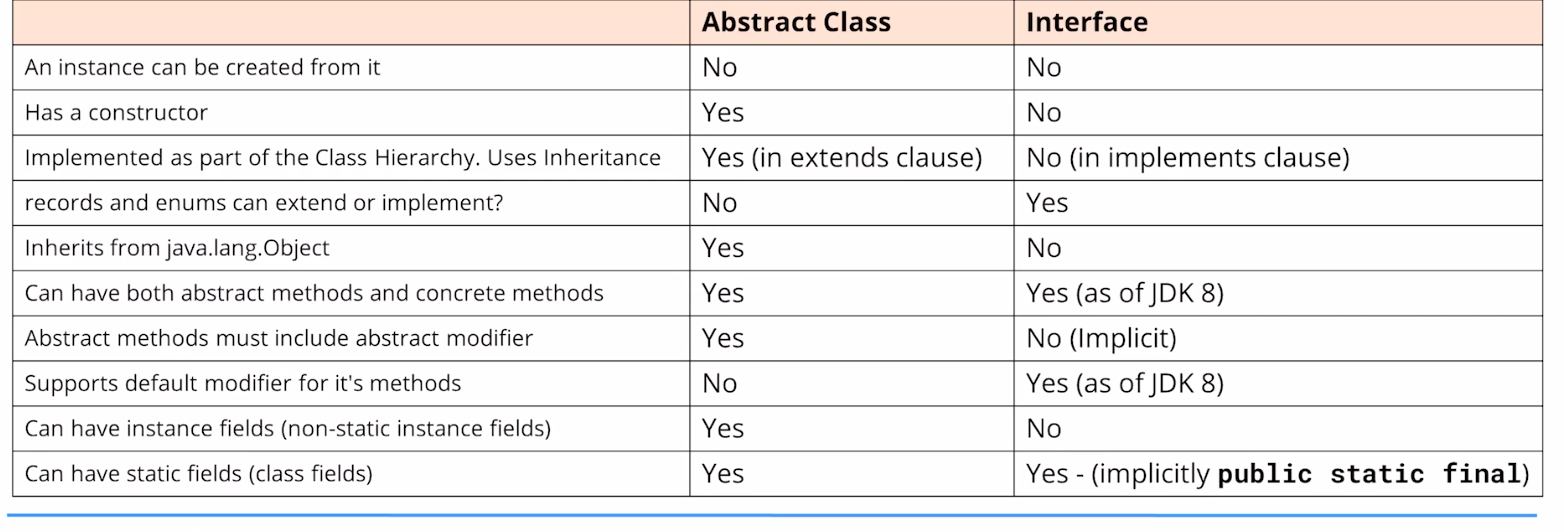Section 11 (Abstraction) in Java. Udemy - Java Programming Masterclass
Section 11 Abstraction in Java
Udemy - Java Programming Masterclass
Abstraction
Notes
keeps the user from viewing complex code
provides the user with only necessary information
- If you consider an elephant, dog, lizard, you would probably say they are all animals
- An animal is a really abstract concept
- An animal doesn’t really exists except to describe more specific things
- If you can’t draw it on a piece of paper it is probably abstract
- Concrete Method
- A method body with at least one statement
- Is set to implement an abstract method if it overrides one
Abstract classes

Can have a mix of abstract and concrete methods
abstract class Animal {- default visibility is package which is something that you cannot specify other than by leaving off any access modifer before declaring the abstract class like this
- visiblitiy of package means that only classes in the same package have access to the abstract class
- The same goes for the abstract methods, if they are not specified, it will default to package
public abstract class Animal {- if we wanted to give access to this abstract class outside of this package you must specify public
Example
1 2 3 4 5 6 7 8 9 10 11 12 13 14 15 16 17 18 19 20 21 22 23
public abstract class Animal { // field properties protected String type; protected String size; protected double weight; // constructor public Animal(String type, String size, double weight) { this.type = type; this.size = size; this.weight = weight; } // methods protected abstract void breathe(); protected abstract void move(int speed); protected abstract void breed(); // final method public final void exists(){ System.out.println("Existing out here"); } }
1 2 3 4 5 6 7 8 9 10 11 12 13 14 15 16 17 18 19 20
public class Dog extends Animal { public Dog(String type, String size, double weight) { super(type, size, weight); } @Override protected void breathe() { System.out.println("panting like a dog"); } @Override protected void move(int speed) { System.out.println("Moving on all 4's at " + speed + "mph"); } @Override protected void breed() { System.out.println("Pour hot water on us if we get stuck again"); } }
Abstract class extending another Abstract class
- when an abstract class extends another abstract class there are a couple of things to keep in mind
- It has the option to implement any number or none of the abstract methods it is extending from
Why Use Abstract classes
- An abstract class in your hierarchy forces the designers of subclasses, to think about , and create unique and targeted implementations, for the abstracted methods
Interface
- A class can implement multiple interfaces but only 1 abstract class
- similiar to an abstract class, although it isn’t a class at all
- by using an interface you must implement all of the abstract methods on the interface
- A class that implements an interface does so it can be known by that type
- keyword interface is used to specify an interface
- You don’t have to put the keyword abstract before every method as it is implicity put there
Visibility
- Visibility of an interface is package by default, meaning only classes in the same package have access to it
the abstract methods can only be labeled with the public access modifer
- interface members are implicitly public
Implementing interface
- An interface cannot implement another interface
- An interface can however extend another interface
public interface iA extends iB {
Examples
1 2 3 4 5 6 7 8 9 10 11 12 13 14 15 16 17 18
/** interface **/ public interface FlightEnabled { abstract void fly(); abstract void land(); } /** implements class **/ public class Bird implements FlightEnabled { @Override public void fly() { System.out.println("Flying through the air"); } @Override public void land() { System.out.println("Getting ready for landing"); } }
Coding to an interface
- incredibly useful and scalable technique for writing systems that are highly dependent on changes.
- “Coding to interfaces, not implementation.”
- Coding to interfaces is a technique to write classes based on an interface; interface that defines what the behavior of the object should be. It involves creating an interface first, defining its methods and then creating the actual class with the implementation.
- Scales well to support new subtypes
- Downside is that alterations to the interface may wreak havoc no the client code
imagine there are 50 subclasses that implement an interface and you make a change, you would have to make that change in 50 other places to they can implement this 1 new method
1 2 3 4 5 6 7 8 9 10 11 12 13 14 15 16 17 18 19 20 21 22
public static void main(String[alt-text] args) { // not coding to an interface // the ArrayList is not an interface but an implementation of a list ArrayList<Integer> ll1 = new ArrayList<>(Arrays.asList(1,2,3,4,5,6,7,8)); // coding to an interface List<Integer> ll2 = new LinkedList<>(Arrays.asList(9,10,11,12)); method1(ll1); method1(ll2); } // again this would not be coding to an interface but the argument is a concrete class and not an interface // public static void method1(ArrayList<Integer> list){ // this is coding to an interface because List is an interfac and can accept any class that implements the List interface public static void method1(List<Integer> list){ for(var x : list){ System.out.printf("%d ", x); } System.out.println(); }
Interface post JDK 8 update
- before jdk 8 the interface could only have public abstract methods
- jdk 8 introduced the default method and the public static methods
- jdk 9 introduced private methods, both static and non-static
Interface Extension method
- part of the jdk 8 update
- an extension method is identified by the modifer default, so it is more commonly known as the default method
- it is a concrete method, meaning it has curly braces and some code within it
- Acts like a method on the superclass because we can override it
- Adding a default method doesn’t break any classes currenty implmenting the interface
Private methods
- jdk 9 gave us private methods both static and not static
- enhancement solves the problem of re-use of code, within concrete methods of an interface
Abstract classes vs interfaces
Abstract classes
- abstract classes are very similiar to interfaces
- you can’t instanciate both of them
- both may contain a mix of methods declared with, or without a method block
- you can use all but the private access modifer, for its abstract methods
- abstract class can extend only one parent class, but can imlement multiple interfaces
Interfaces
- just a declaration of methods, which you want some classes to have, its not the implementation
- in an interface we define what kind of operations an object can perform
- since jdk8 can contain methods with implementation for backwords compability reasons
- since jdk9 can contain private methods, commonly used when default methods share common code
Coding Challenge
This post is licensed under CC BY 4.0 by the author.

